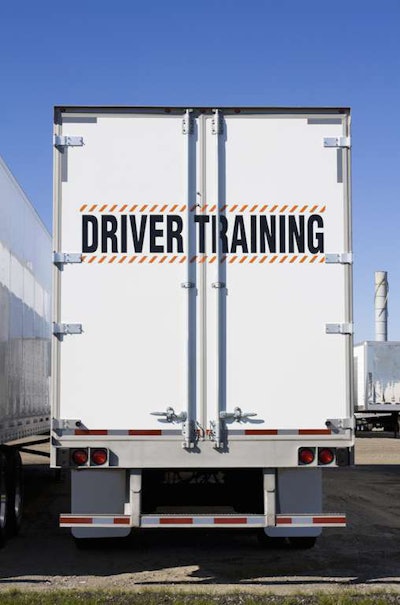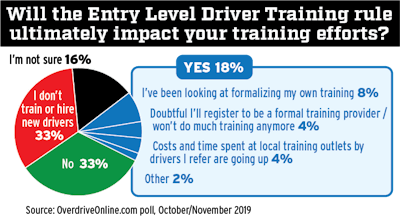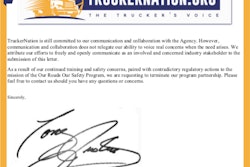
Updated Feb. 7, 2020: The comment period on FMCSA‘s notice to extend the effective date of the rule is open until mid-March. The original story below was published Jan. 29.
The Federal Motor Carrier Safety Administration plans to delay for two years the implementation of a federal rule establishing, for the first time, training standards for entry-level truck drivers.
The rule was set to go into effect in just over a week — Feb. 7, 2020. It is now scheduled to take effect Feb. 7, 2022. The rule was made final in early 2017, with a three-year window before it took effect to allow FMCSA, trainers, fleets and states time to implement the necessary systems and procedures. With the delay, stakeholders have two additional years to comply.
“Following a careful review of the public comments regarding the Entry-Level Training (ELDT) rule, FMCSA is extending the rule’s implementation for two years. This extension is reflective of the agency’s continued efforts to develop a secure and effective electronic trainer provider registry for the new rule. The agency remains committed to making the implementation of the rule as efficient and effective as possible,” FMCSA said in a statement.
The agency will accept public comments on the delay for 45 days after it is published in the Federal Register in the coming days.

The rule applies to CDL applicants who receive their licenses after that date.
Required training in the rule – both classroom and behind-the-wheel driving – includes the basic operation of a vehicle, vehicle control systems and dashboard instruments, pre- and post-trip inspections, backing and docking, distracted driving, roadside inspections, hours of service, driver-whistleblower protections and procedures, and more.
The training must be completed by an FMCSA-approved provider from the Training Provider Registry established by the rule, which remains at this date a work in progress.
FMCSA already delayed in July the implementation of two parts of the rule – the requirement that trainers upload drivers’ certification information into the agency’s database and the requirement that states confirm that CDL applicants have complied with the new training standards before allowing them to take a CDL skills or knowledge test.
Don Lefeve, head of the Commercial Vehicle Training Association, said the group is frustrated by the delay, noting that the rule is already years late on the statutory deadline set in 2012 by Congress, who called for the rule to be made final within three years. “The ball has been dropped,” he said. But, he adds, “I feel like the leadership of FMCSA understands the significance of” the rule, “and I feel like they have a plan for moving forward.”
The lynchpin, ultimately, will be the Training Provider Registry that FMCSA requires any pre-CDL training organization to register within, self-certifying that their program is compliant with the rule.
The difficulty of putting the registry together, sources inside FMCSA have said, is one of the reasons the rule has been delayed.
Looking at that crucial portion of what the rule requires, “we suspected a few years ago, ‘we’re not sure [the government] is going to pull that off'” in time, said Laura McMillan, vice president of training for Instructional Technologies, Inc. (ITI). McMillan added that since that time, she’d heard much about the difficulties/delays the government had experienced putting all of the technical pieces together, particularly as they relate to state agencies who are primary in the licensing process. With FMCSA‘s earlier-2019 proposal to delay the two technical portions of the rule that essentially limited governments’ ability to enforce it, “they received a lot of comments [from state agencies] that requested a full delay.”
 Overdrive asked this poll question of its readership well before rumors of a delay in the training rule became widespread in late November. As shown, about a third of owner-operators and small fleet owners responding either weren’t sure how the rule, when implemented, would affect their ongoing training efforts or speculated on a variety of possible effects. Some (8 percent) saw potential for formalization of the kind of informal apprenticeships that have been part and parcel of many owner-ops’ lives over the years — a chance perhaps to embrace new pre-CDL standards and trainer certification procedures toward building the next generation of safe drivers through a close acquaintance with the business of trucking. For further discussion of the idea that the training rule presents opportunity for enterprising trainers among working haulers, listen further to the podcast at this link featuring a conversation with operator Scott Hainline on training.
Overdrive asked this poll question of its readership well before rumors of a delay in the training rule became widespread in late November. As shown, about a third of owner-operators and small fleet owners responding either weren’t sure how the rule, when implemented, would affect their ongoing training efforts or speculated on a variety of possible effects. Some (8 percent) saw potential for formalization of the kind of informal apprenticeships that have been part and parcel of many owner-ops’ lives over the years — a chance perhaps to embrace new pre-CDL standards and trainer certification procedures toward building the next generation of safe drivers through a close acquaintance with the business of trucking. For further discussion of the idea that the training rule presents opportunity for enterprising trainers among working haulers, listen further to the podcast at this link featuring a conversation with operator Scott Hainline on training.Professional Truck Driver Institute (PTDI) Executive Director Tim Blum said schools should use the extra time they now have to get ready for making certain their programs comply with the rule. “I look at this as an opportunity for the schools to get ready,” he said. “A lot don’t understand it, and a lot don’t even know about it. This is a period we can help people.”
Blum’s organization’s long been a voluntary standards-certification group for pre-CDL truck driver training organizations whose current standard, he says, already exceeds what’s required by the ELDT rule. Blum bases part of his thoughts on schools’ preparedness around the rule on the reality that his organization has not in recent memory seen much of an uptick in new interest in schools’ obtaining the PTDI certification — by doing so, they could have peace of mind that their programs comply with the rule.
There are resources obtainable via PTDI, too, in the form of a guidebook the group published that breaks down the rule’s requirement of classroom/theory, driving range and behind-the-wheel skills portions of the required training.
“It breaks down the government standard for Class A, Class B, and all the endorsements,” he said. “When you look at it, you can see that there could be an option for the student to get the theory someplace and the behind-the-wheel training someplace else,” perhaps an opportunity for smaller fleets without huge resources to invest in outside classroom instruction but utilize their own resources with plenty experienced truckers who have a knack for hands-on road training.
McMillan echoed Blum about schools’ preparations, which her organization supports with its online-training modules that can fulfill the theory portions of the newly required testing, when the rule comes into play now in 2022. The ELDT rule, she said, mandates a professional certification, essentially, for any entry level CDL driver.
“In our conversations with clients and others in the industry,” she said, “though they don’t necessarily like the idea of new rules and regulations, everyone can agree that’s really the right thing to do.” And regardless of how long it will take for the technical systems to support the newly required training to stand up, “none of that’s changing.”












